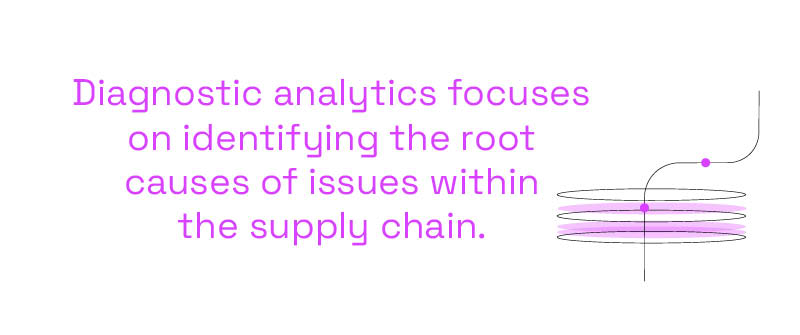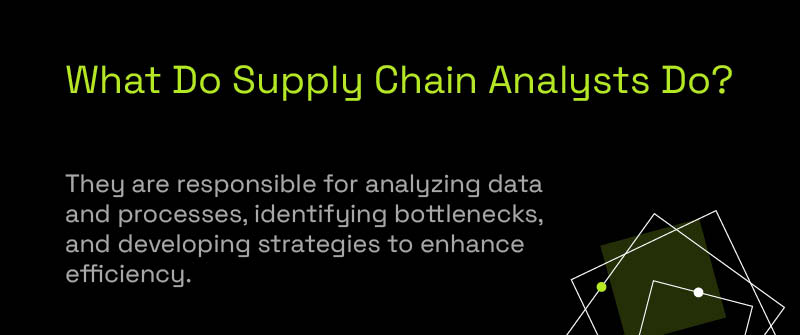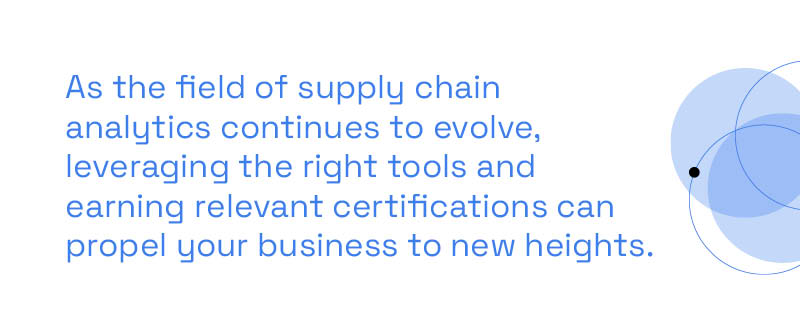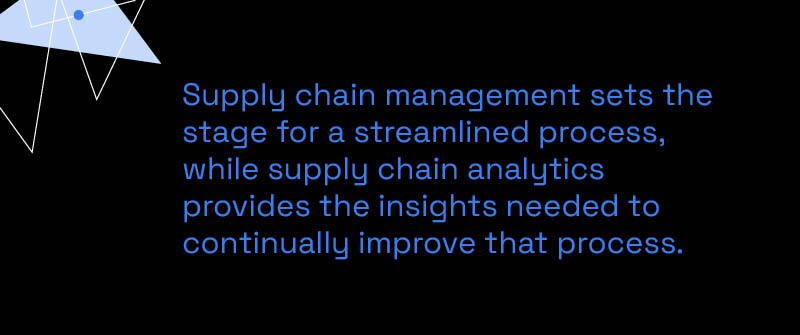
What Is Supply Chain Analytics?
It encompasses various techniques and technologies to help businesses understand, predict, and optimize their operations from sourcing to delivery. By leveraging manufacturing data analytics, businesses can gain deeper insights into their production processes, identify inefficiencies, and make data-driven decisions that improve performance and reduce costs.
Definition and Scope
In essence, supply chain analytics refers to the tools and processes organizations utilize to analyze and gain insights from the vast amounts of data associated with supply chain activities, translating complex data into actionable intelligence and enabling business leaders to make informed decisions. It covers a wide range of areas, including data analytics for inventory management, demand forecasting, logistics optimization, and cost reduction.
History and Evolution
The concept of supply chain analytics has evolved significantly over the decades. Initially, it focused on basic metrics and manual data analysis. However, with advancements in technology, the scope has expanded dramatically. Today, it includes sophisticated tools like AI, machine learning, and real-time data processing, allowing businesses to achieve unprecedented levels of efficiency.
Importance in Modern Businesses
In modern businesses, the importance of supply chain analytics cannot be overstated. Modern supply chain analytics leverage data to enhance and streamline supply chain operations globally, providing manufacturing data visualization and insights across logistics networks. Companies that invest in robust analytics capabilities gain a competitive edge by optimizing their operations, reducing costs, and improving customer satisfaction. For instance, a well-analyzed supply chain can reduce lead times, streamline inventory levels, and enhance supplier relationships, ultimately leading to a more resilient and responsive business model.
What Are The Five Common Types Of Supply Chain Analytics?
Unlocking the full potential of your supply chain begins with understanding and implementing the five common types of supply chain analytics. Supply chain data analytics involves computationally analyzing systems and processes within the supply chain to transform raw data into actionable insights. Each type plays a critical role in transforming raw data into actionable insights that drive efficiency, cost savings, and strategic decision-making.
Descriptive Analytics: Historical Data Analysis
Descriptive analytics is the foundation of all supply chain analytics. It involves the examination of historical supply chain data to identify patterns, trends, and relationships. By leveraging predictive supply chain analytics, businesses can gain insights into past performance and understand the current state of their supply chain. This type of analysis is crucial for establishing baselines and benchmarking performance.
Predictive Analytics: Forecasting and Predictions
Predictive analytics advances your analytical capabilities by enabling you to forecast future outcomes based on historical data. It can help forecast customer demand and adjust supply chain operations accordingly. This involves statistical models and machine learning techniques to predict trends, demand, and potential disruptions. For instance, predictive analytics can help determine future inventory needs or identify potential bottlenecks in the supply chain.
Prescriptive Analytics: Optimization and Decision-Making
While descriptive and predictive analytics provide insights, prescriptive analytics goes a step further by recommending specific actions. By applying optimization algorithms and advanced analytics, this type of analysis suggests the best course of action to improve supply chain performance. This could involve recommending optimal inventory levels, transportation routes, or supplier choices.
Diagnostic Analytics: Root Cause Analysis
Diagnostic analytics focuses on identifying the root causes of issues within the supply chain. When anomalies or inefficiencies are detected, diagnostic analytics digs deep into the data to discover why they occurred. This involves a combination of data mining and statistical analysis to pinpoint the specific factors that led to a problem, enabling businesses to address and mitigate these issues effectively.

Cognitive Analytics: Advanced AI and Machine Learning Applications
The most advanced of the five types, cognitive analytics, employs artificial intelligence (AI) and machine learning to interpret complex data sets and automate decision-making processes. Cognitive analytics can identify patterns and trends that are not apparent through traditional methods. Keep in mind that cognitive analytics is not an end-all process. It is intended to simulate human thought processes but to be thought-provoking, not just a one-and-done analysis. AI-powered chatbots, demand forecasting, and autonomous supply chain planning are just a few examples of applications for cognitive analytics in supply chain management.
By integrating these five types of supply chain analytics into your operations, you can create a more resilient, efficient, and responsive supply chain, positioning your business for long-term success.
What Do Supply Chain Analysts Do?
Key Responsibilities and Tasks
Supply chain analysts play a pivotal role in optimizing and streamlining procurement, manufacturing, distribution, and every other process within the supply chain. Tracking and analyzing raw materials is crucial for ensuring transparency, optimizing supply chain functionality, and mitigating risks associated with market volatility and external disruptions. They are responsible for analyzing data and processes, identifying bottlenecks, and developing strategies to enhance efficiency. Their insights help businesses reduce costs and improve service levels.

Skills and Qualifications Required
A successful supply chain analyst must have a combination of technical and soft skills. Technical skills include proficiency in supply chain analytics tools, advanced Excel functionalities, and knowledge of ERP systems. Familiarity with machine learning and predictive analytics can significantly enhance their capabilities. Soft skills include strong problem-solving abilities, effective communication, and the ability to work under pressure.
Career Paths and Job Outlook
The demand for supply chain analysts is on the rise, driven by the need for organizations to maintain competitive advantages through efficient supply chain operations. Roles such as logistics manager, procurement analyst, and operations manager are common career progressions for supply chain analysts. According to industry reports, job opportunities in supply chain analytics are expected to grow steadily over the next decade. The Bureau of Labor Statistics (BLS) predicts 28% growth from 2021 to 2031 for logisticians, a category that includes supply chain analysts. As of May 2021, the average annual salary for this position was $77,040.
Examples of Daily Tasks and Challenges
On a daily basis, supply chain analysts might find themselves extracting and analyzing large datasets to identify trends and predict future demands. They collaborate with cross-functional teams to implement process improvements, monitor supply chain performance metrics, and resolve logistics and distribution issues. Challenges often include dealing with incomplete data, managing supplier relationships, and responding quickly to unforeseen disruptions.
What Is The Supply Chain Analysis Approach?
In today’s fast-paced business environment, leveraging supply chain analysis methodology is essential for staying competitive. The supply chain analysis process involves a series of methodical steps designed to transform raw data into actionable insights that can drive strategic decision-making and operational efficiency. Let’s delve into the specifics of this approach to understand how it can revolutionize your business operations.
Step-by-Step Analysis Process
The journey begins with data collection. This involves gathering relevant data from various points in the supply chain, including suppliers, production facilities, warehouses, and distribution channels. The next step is data cleansing, where the collected data is reviewed for accuracy, consistency, and completeness. Once the data is prepared, it moves into the analysis phase.
During the analysis phase, different analytical techniques are applied. Descriptive analytics can reveal patterns and trends in historical data, while predictive analytics uses statistical models to forecast future scenarios. Prescriptive analytics then offers recommendations on optimizing operations to achieve desired outcomes. Lastly, cognitive analytics employ AI and machine learning to provide advanced insights and automate decision-making processes.
Tools and Technologies Used
The efficiency of the supply chain analysis process heavily relies on modern tools and technologies. Advanced software platforms like SAP, Oracle SCM Cloud, and Microsoft Dynamics 365 are just a few examples of the technological assets that can streamline this process. These tools facilitate data integration, provide sophisticated analytics capabilities, and offer real-time insights that empower data-driven decision-making.
Bar Keeper’s Friend Case Study
One compelling example of successful supply chain analysis is the case study of Bar Keeper’s Friend, a cleaning products manufacturer. Faced with rising transportation costs and fluctuating demand, the company embarked on a comprehensive supply chain analysis. By leveraging advanced analytics tools and following a structured analysis process, they were able to identify inefficiencies in their distribution network and optimize their transportation routes.
The implementation of these strategies resulted in a 15% reduction in transportation costs and a notable improvement in delivery times. Additionally, by enhancing their demand forecasting accuracy, Bar Keeper’s Friend managed to reduce stockouts and overstock situations, thereby improving customer satisfaction and operational efficiency.
Best Practices
For successful implementation, it’s crucial to adhere to several best practices. Firstly, ensure data quality by regularly cleaning and validating your data sources. Secondly, adopt a holistic approach that integrates data from all points in your supply chain. Thirdly, invest in the right tools and technologies that match your business needs. Finally, foster a culture that values data-driven decision-making, encouraging your team to consistently utilize analytics insights.
By embracing a robust supply chain analysis methodology, you can unlock the true potential of your supply chain, driving efficiency, reducing costs, and ultimately gaining a competitive edge in the market.
Supply Chain Analytics Tools and Certifications
As the field of supply chain analytics continues to evolve, leveraging the right tools and earning relevant certifications can propel your business to new heights. Understanding which tools are available and which certifications hold value can make a significant difference in both operational efficiency and strategic decision-making.

Overview of Popular Tools
There are numerous tools available to assist in supply chain analytics, each offering unique functionalities. Among the most prominent is Microsoft Fabric, a holistic platform that integrates data from various sources, enabling seamless analysis and reporting. It’s designed to support data-driven decision-making across the supply chain.
Another essential tool is Azure, Microsoft’s cloud computing service. Azure offers a range of services that support advanced analytics, including machine learning, IoT, and cognitive services. Its flexibility and scalability make it ideal for businesses of all sizes looking to enhance their supply chain analytics capabilities.
Similarly, other tools like SAP Integrated Business Planning and IBM Watson Supply Chain provide sophisticated analytics solutions tailored for supply chain optimization. Choosing the right tools often depends on specific business needs, budget constraints, and existing technological infrastructure.
Benefits of Different Certifications
Earning a supply chain analytics certification not only enhances your resume but also equips you with the latest knowledge and best practices in the field. Certifications such as the APICS Certified Supply Chain Professional (CSCP) and the Institute for Supply Management (ISM) Certified Professional in Supply Management (CPSM) are highly regarded in the industry. These programs cover a wide range of topics, including analytics, procurement data analytics, and logistics, to ensure you have a well-rounded skill set.
Specialized certifications in supply chain analytics, such as the SAS Certified Specialist: Visual Business Analytics or the Certificate in Supply Chain Analytics from various universities, focus more on the analytics aspect, providing deep dives into data manipulation, statistical analysis, and machine learning applications within the supply chain context.
Recommended Courses and Training Programs
To stay ahead in the dynamic field of supply chain analytics, continuous learning is crucial. There are several recommended supply chain analytics courses and training programs that can help you enhance your expertise. Institutions like MIT, Coursera, and edX offer online courses that range from introductory to advanced levels. These courses often include hands-on projects and real-world case studies to reinforce learning.
For more in-depth training, consider enrolling in a professional certification program or executive education courses that delve into strategic supply chain analytics. Programs such as the MITx MicroMasters Credential in Supply Chain Management provide a comprehensive curriculum that covers everything from data analytics to supply chain strategy, ensuring you are well-equipped to tackle complex supply chain challenges.
Supply Chain Analytics vs Supply Chain Management
In the evolving landscape of modern business, understanding the distinction between supply chain analytics and supply chain management is pivotal. While both fields are integral to the efficient operation of a business, they serve complementary yet distinct functions within an organization.
Key Differences and Similarities
Supply chain management encompasses the end-to-end coordination of goods and services, from raw material acquisition to customer delivery. It involves the planning, execution, control, and monitoring of supply chain activities with the objective of creating net value and building a competitive infrastructure. On the other hand, supply chain analytics refers to the use of data and analytical tools to understand, predict, and optimize supply chain operations, integrating data-producing elements within supply chains to enhance analyses that inform strategic decisions.
While supply chain management is action-oriented, focusing on practical implementation and operational efficiency, supply chain analytics is more data-driven, emphasizing data insights and predictive modeling to inform strategic decisions. Both fields require a deep understanding of logistics, but they approach problem-solving from different angles.
How They Complement Each Other
When integrated effectively, supply chain management and supply chain analytics can transform an organization’s operational capabilities. Supply chain management sets the stage for a streamlined process, while supply chain analytics provides the insights needed to continually improve that process. For instance, analytics can identify patterns and trends that inform better demand forecasting, inventory management, and risk mitigation strategies.
By unifying these two domains, businesses can achieve enhanced visibility, increased responsiveness, and improved overall performance. This synergy enables leaders to make informed, data-backed decisions that drive efficiency, reduce costs, and boost customer satisfaction.

Industry Use
Several industries exemplify the successful integration of supply chain management and analytics. In the retail sector, giants like Amazon utilize analytics to optimize their supply chain, from demand forecasting to inventory management, ensuring that products are delivered in the most efficient manner. In the automotive industry, companies like Toyota leverage analytics to manage their complex supply chain networks, improving both production and distribution processes.
As each of these examples illustrates, the convergence of analytics and management practices can lead to significant operational improvements and competitive advantages.
Unlock the full potential of your supply chain with P3 Adaptive. Our expert consultants transform an array of data points into one cohesive, powerful view. Gain the actionable insights you need to streamline your operations and make confident decisions, propelling your business forward with clarity and precision.Contact us today to get started.
Get in touch with a P3 team member